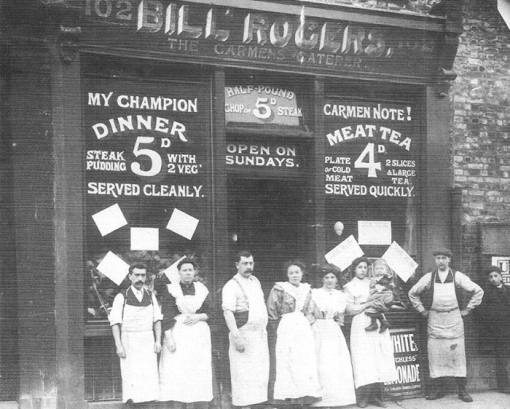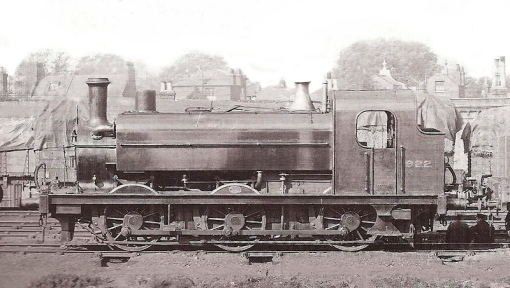April 2010
Monthly Archive
April 30, 2010

In 1906, at 102 Whitechapel Road, Bill Rogers’ Dining Rooms for Carmen could be found. This establishment is ideal for transposition to Artillery Lane with all the goods depots nearby. Carmen were delivery drivers – the White Van Man of the period, and London’s roads were jammed packed with their horse-drawn, carts, wagons and vans. Nothing changes.
Rogers’ rooms appear to have aimed a little above the usual (eel) pie & mash shop, instead proudly serving plates of cold meat, chops, steak or steak and kidney pud with two veg, and not forgetting the essential large tea…and I’ll bet there weren’t any slugs in the lettuce either.
I was intrigued by the R Whites Lemonade board – Google surprised me by revealing the drink was first produced in 1845.
We’re firmly in Basilica Fields territory here; St. Mary’s station was opened by the East London Railway, and was also used by District Line trains, and is next door but one to the right. The station received a direct hit from a bomb in 1940, destroying it completely, and severely damaging the Rivoli cinema next door, and number 102 can be seen at the far right of the image.
Remarkably 102 still stands, now an Islamic book & media shop sandwiched between the Citroen garage and Alvin Lee.
April 30, 2010

Oops, I missed this class out from the first block of locos.
The 921s were Stirling’s final saddle tank design, and they first entered traffic at the end of 1892. Initially the class was intended to deal with the increasing goods and mineral traffic over the Widened Lines to and from the London, Chatham & Dover Railway over the Thames via Ludgate Hill and Blackfriars, and thus the first six (and later a floating total of approximately 25) of the domeless locos were fitted with condensing gear. Their success ensured the class multiplied to 52 in 1897, by which time they could be found on goods and shunting duties across the system.
The class will be active on EWL goods and mineral duties through Artillery Lane from and to both Kings Cross and Ludgate Hill to the docks and New Cross via Basilica Fields. 922, the second member of the class to be built is seen here in the late 1890s, with the evidence of cross-London transfer workings all around in the form of LC&DR wagons and tarpaulins.
The heavily weathered and stained paintwork once again lends credence to the argument that not all was sparkly and bright in the Victorian pre-Grouping period.
April 28, 2010

By the time Patrick Stirling was appointed Locomotive Superintendent of the GNR in 1867, the second series of his predecessor’s twenty outside-framed 0-4-2 Back Tanks were just being delivered, but it was already clear that alone they were unable to cope with the sheer volume of the fast-growing suburban traffic. Stirling therefore produced a revised version of Sturrock’s 241 and 270 classes by designing an 0-4-2 Well Tank with inside frames for the leading coupled wheels, which were classified the 126 class.
Thirteen examples were built by Doncaster between 1868 – 1871, and they began to displace some of the earlier classes from Widened Lines duties, although those affected initially only went as far as Hatfield, with some remaining at Kings Cross.
Between 1884 and 1889, 4′ 2½” straightback boilers replaced the original 4′ 0½” ones, and like the 120 class, five locos gained Ivatt’s 4′ 5″ domed boilers between 1899 and 1907. The introduction of Ivatt’s Atlantic C2 tank in 1897 saw the gradual displacement of the class to more rustic climes, although members of the class hung on tenaciously to Widened Lines duties until as late as 1904, and withdrawal commenced the following year.
Between 1903 and 1905, all members of the class were placed on the duplicate list to leave their numbers free for Ivatt’s new 0-8-2T, 1905 also being the year of the first of the classes withdrawals.
Of course, as with many of the Widened Lines locomotives, the trade is unsurprisingly silent, so I will be scratchbuilding an example of the class.
Number 121, seen here c1904 carries the 4′ 2½” straightback boiler, and has had its original wooden brakes replaced by more modern iron ones.The splasher cutouts have been plated over, and coal rails added to the bunker, though I’m at a loss to describe the function of the bracket on the smokebox.
With the current dearth of info on the GN 4-wheeled suburban stock, this post brings to an end the introduction to the four main companies which will be present on Basilica Fields in the first phase of building, and in the earlier period of 1890 – 1897/8. There are two or three directions the blog could take from the next post onwards – the later period on 1897/8 – 1906/7, I could introduce the wider concept of the line and bring in the other companies vying for a slice of the cake, or move on to matters up on the viaduct with the Great Eastern.
April 26, 2010

Kirtley’s 690 class has already been touched upon by way of my post on the closely related 780 class. These six locomotives were delivered in 1869 from Messrs Beyer Peacock specifically for the coal traffic via the Widened Lines to Herne Hill and Battersea which commenced on 17 November 1868 (in fact, the tender for the locos was accepted the following day). The route taken involved the 1:38 incline from Farringdon to Blackfriars which imposed a severe weight limitation on the trains, and the class performed very well on these duties, which then expanded to also include goods trains.
Initially fitted with hand brakes to wooden blocks, the 690 class were given steam brakes in 1878 which clearly defined their goods only role, as the 780 class were fitted with Smith’s simple vacuum for passenger duties later that year. In 1882, the 690 class were also fitted with Sanders automatic brake which continued to segregate them from the 780 class, as they were unable to operate the Smith’s brakes on the Midland’s carriages, and it wasn’t until 1888 that the superior automatic brake was finally fitted to the 780 class, enabling the 690 class (at least on paper) to finally work passenger duties. The 690 class continued to work on Widened Lines goods and coal duties until the introduction of the 2441 class in 1899.
Aesthetically, the 690 class went through many changes up to the Basilica Fields period, and 692 is seen here post-1898 on the duplicate list. At this time, some members of the class had the position of the numbers and maker’s plates transposed. Cabs were been fitted between 1888 and 1893 when the Kirtley boilers were scrapped and Johnson’s C Class boilers fitted, which resulted in an immediate visual difference between the 690 and 780 classes in the route taken by the condensing pipes from the smokebox.
Up to rebuilding, members of the class were probably still in the green livery, but once in crimson lake, the fully decorated ‘Kentish Town’ lining style appears not to have been applied to the 690 class, and although above the footplate they were fully lined, it would seem only the outside cranks and wheels were so treated below.
April 24, 2010

Stirling’s 120 Class of 0-4-4BTs (back tanks) were designed to improve the rough bunker-first running experienced on both his and Sturrock’s earlier 0-4-2Ts. The Midland had already introduced successful 0-4-4T designs for Widened Lines duties in Kirtley’s 690 and 780 classes, and the 120 Class were in many respects a bogie version of his 126 Class 0-4-2WT, however, the 120s had a 1000 gallon tank located in the bunker (as the bogie precluded the use of a well tank) and there was still room for 2½ tons of coal on top.
Forty two members of the class were built in small batches between 1872 and 1881, and over the years twenty six of the class were fitted with condensing apparatus to work on the Widened Lines. From 1886, all bar two of the class had their 4′ 2½” boilers replaced by 4′ 5″ straightbacks, and five locos eventually gained domed Ivatt boilers in the early years of the 20th century. During their lifetime many members of the class had modifications to their wrap-over cabs in an attempt to give the crews more protection, and the five which received domed boilers were also fitted with Stirling’s enclosed cabs wrapped laterally.
In the photo above, number 244 of 1878 is seen at Hatfield in 1902. She had received the 4′ 5″ straightback boiler in 1891, her splasher cutouts were plated over around this time, and she was to last in service for another eleven years. The tank condensing vent pipe can just be seen in the bunker hard up against the rear of the wrap over roof, on the side nearest the camera.
Not much chance of a kit appearing for this loco, so I’m looking for a drawing which will aid in scratchbuilding her – any help much appreciated.
Next Page »




